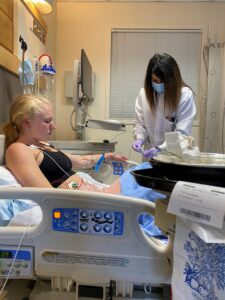Neurologist’s daughter’s near-stroke ignites passion for stroke education

MultiCare Neuroscience Center Neurologist Greg Bell, MD, has been with MultiCare for nearly three years and has worked in the field for 20 years. Dr. Bell relishes the sleuthing opportunities that come with each diagnosis.
Part of his practice includes seeing patients for issues with stroke care, something that has personally touched two people in Dr. Bell’s life.
“My dad has had stroke events, which meshes with the idea that stroke is an older person’s issue,” he says. “In reality, about a third of people who have a stroke are under 65. It can also happen to young adults and even children. I think people aren’t aware of the fact that this can affect anybody. My daughter is a perfect example. She’s 25 years old, is extremely healthy, a very active person — she’s the last person you’d consider for having stroke symptoms.”
Dr. Bell’s daughter, Grace Bell, began experiencing shoulder and neck pain on one side of her body in August 2020. Gyms had recently reopened, and she attributed the pain to her body getting used to working out again. The pain worsened and was accompanied by a 10-day migraine-like headache.
“By the end of the day, I would get a ton of auras (or sensory disturbances),” Grace says. “And then, I started not being able to see. From here (points to eyes) down was watery, and in the morning, it still hadn’t gone away. So, I went to the ER,” Grace says.
Beforehand, Grace called her dad and described what she was experiencing. Dr. Bell recognized the symptoms and suspected she had a vertebral artery dissection. These arteries are located in the neck and are the primary vessels that feed important structures, such as vision centers, the brain stem and balance. Damage to these arteries can also form clots, which can travel to the brain, causing temporary or permanent stroke symptoms.
At the hospital, Grace shared her father’s recommendation for getting vascular imaging done, and it was confirmed that she had a tear in the lining of both blood vessels, along with a large clot. She was immediately hospitalized for three days, put on blood thinners and then sent home to begin the long road to recovery.

Grace Bell in the hospital following her vertebral artery dissection diagnosis.
“Clinically, I’ve been so lucky. I can’t even express how lucky I am,” Grace shares. “It really reframed how I want to live my life and do something that matters (she just started a nurse practitioner program).”
Grace is one of the lucky ones. With a single tear, between 70 to 85 percent of people will have permanent stroke damage.
For Dr. Bell, this personal experience is a testament to the importance of recognizing stroke signs and treating them early, along with educating medical staff and the community.
“Twenty-five percent of people will have a stroke event during the course of their life, and it has been estimated that for every minute that you delay therapy, that person loses four million neurons and up to a total of 12 million brain cells,” he says.
With community donations to help grow stroke care at MultiCare Good Samaritan Hospital, Dr. Bell is excited for the hospital’s ability to improve the quality of life for our communities, from a community education perspective — teaching what to look for and what to do when something happens that isn’t right — to education opportunities within our hospitals. This includes creating efficiencies and helping underserved populations when it comes to stroke care.
As for those who have already championed the cause, Grace says, “Donors are definitely putting their money in a very needed place. It’s a good investment to help the greater health of people in this area.”
“There are great opportunities for us to improve health care in our communities, and we can make a real difference,” Dr. Bell adds. “Small donations can help provide valuable education. Larger donations open the door to new and cutting-edge technologies for all patients, especially those in outlying and underserved areas.”
During MultiCare Good Samaritan Foundation’s 15th annual Corks & Crush fundraising event on May 15, attendees raised more than $711,000 to expand stroke care at Good Samaritan Hospital. Community donations will help train nurses in the continuous evolution of stroke care, reduce door-to-treatment times to decrease inpatient mortality and educate East Pierce County about stroke symptoms and prevention.
You can help more people in our community have better stroke outcomes with a gift today.




